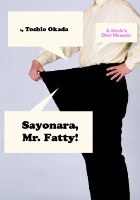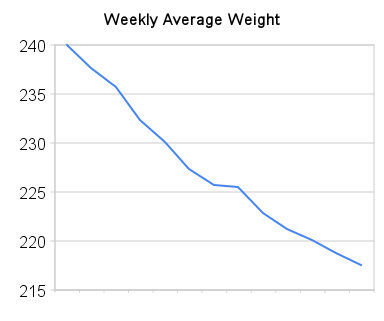Book Review: Sayonara, Mr. Fatty!
 Like most people, I made just one New Years Resolution last January: 2009 was going to be the year I was going to get in shape!
Like most people, I made just one New Years Resolution last January: 2009 was going to be the year I was going to get in shape!
I had gained a lot of weight from college, and I’ve kept it on for the few years since graduation. I was six feet tall and 238 pounds. So my goal was to be under 200 by the end of the year, which would be reasonable for a man of my size and body type.
It couldn’t be any easier for me as a new gym had just opened a few blocks away from my apartment. So I joined the gym and for the first half of the year, I worked out three days every week.
But there was a problem. Sure, I lost weight as soon as I started working out, but for some reason, I just couldn’t get under 232 lb. I was working my ass off on the treadmill and lifting weights, but it quickly became apparent to me that the work was not paying off.
So around Otakon, I gave up hitting the gym. In the few weeks after that, I had rebounded up to 243 pounds, the most I have ever weighed in my life. That’s when I finally decided to pick up my review copy of the diet book Sayonara, Mr. Fatty! A Geek’s Diet Memoir from Vertical Publishing.
And this book has possibly changed my life forever.

Anime fans may be familiar with the early-90’s OVA series Otaku no Video from Studio Gainax. The series was a semi-autobiographical look at how the anime studio got its start, and one of the main characters was a little fat man based off of Gainax founder Toshio Okada, or “The Otaking” as he’s better known around the industry and fan community.
In real life, Okada was a 5’7” Japanese man who weighed 260 pounds. Fed up with being fat all his life, he finally found a diet plan that worked for him. Over the course of a year, the Otaking was able to lose 110 pounds to finally have a normal weight for his body type. Quite a marvelous feat for anyone to accomplish, and everyone around him wanted to know just how he managed to do it. So he wrote Sayonara, Mr. Fatty! and described his diet plan in 5 simple steps.
Okada begins his book by explaining all the different methods of dieting and weight loss, and provides all the risks and benefits that come with each one. This is the first sign that Okada, being a typical nerd, thinks in terms of science and logical reasoning. By comparing his method with all the other options using tables and charts, he is able to convince the reader that his way is the easiest method of dieting with as little risk as possible.
Simple, logical, and risk free is exactly what his method is. Without giving out too much of the secret, I can tell you that the Otaking’s diet involves gradually disciplining you, a fatty, into thinking the same way about food that a normal sized person would. He encourages the reader to take their time, and rather than start off with the diet, just eat what you normally would eat while keeping a written record of your eating habits.
That’s the reason why this is the “Geek’s Guide to Dieting,” Okada’s method is based purely on observing oneself in a scientific way, and then when you’re ready to move on to the later stages, you form a diet plan based solely on calorie numbers and basic mathematics. The end result is a simple, logical reasoning that I (as a computer nerd) found to be easy to understand. And since I had such a good understanding on the science and logic behind it, I felt more motivated to partake in the diet.
Another huge source of motivation is Okada’s understanding and overall positive tone through out this book. At 260 pounds prior to dieting, he was a genuine fatty. But he is very blunt and honest about this condition, and he talks to his reader one-on-one, fatty-to-fatty, about it. Because of this familiarity, I found myself putting more trust in the Otaking’s advice than I would with any fitness instructor. After all, why would I trust a skinny fitness instructor? He doesn’t know what it’s like to be fat.
So how did Okada’s method work on me, the guy who couldn’t get under 232 by just working out at the gym?
Well, with the Sayonara method, I quickly realized that my problem was that even though I was working out, I ate a lot of food, way more then I should have been. I was making the trip to McDonalds after each workout, and adding on enough items from the dollar menu completely ruined whatever calories I lost in the gym.
By just simply monitoring my diet, as Okada had suggested in step one, and then looking at the caloric intake, as is step two, I was able to quickly see where that extra weight was coming from. So I was more than prepared to form a proper diet plan at step three, and the end result was amazing.
Over the course of 90 days, I went from 243 pounds to 216. That means I lost 27 pounds, over 11% of my body weight, in just three months! I crossed that dreaded 232-pound milestone on day 27, and I did it without stepping into the gym once the whole time. I was losing all this weight simply by dieting.
Okada’s method will not help you rapidly lose weight like a lot of diet plans will, but starting from Day 1, you’ll notice a gradual loss over time. Your body will naturally fluctuate. Some days you lose two pounds, and some days you may gain a pound. But if you take a weekly average of your weight like I did, you will see that the diet is, in fact, working:

I experienced losing around 2 pounds each week on average, which is what doctors recommend as being a healthy rate. And because it’s gradual like this, I found it to be much easier to manage the diet and continue doing it week after week. After 3 months, I still have no intentions of stopping this diet or rebounding any time soon.
Now you may have noticed that in that graph, there is one week where I didn’t really lose any weight. Okada actually writes about this in this book. He calls it the “75 Day Breakdown” and it’s supposed to be your cue to move from step three to step four in his diet plan.
The “75 Day Breakdown” actually happened to me around Day 50. Okada offers several suggestions on how to overcome the breakdown, and one of the suggestions was exercising. So at Day 50, I went back to the gym and have been working out once a week since then. As you can see by the graph, my weight loss resumed at this point, and it continues to go at a constant rate.
Those numbers don’t lie. Toshio Okada’s Sayonara, Mr. Fatty! diet book actually worked for a fat geek like me. I’ve already lost 27 pounds because of it, and at this rate, I will be at that ideal 200 by the end of the year. I will probably make my New Years Resolution this year thanks to the Otaking!
All of you skinny folks need not apply. If you are a fatty in need to lose weight, and you like to think in terms of science and mathematics, you must check out this book and give his method a shot. I really can’t recommend it enough.